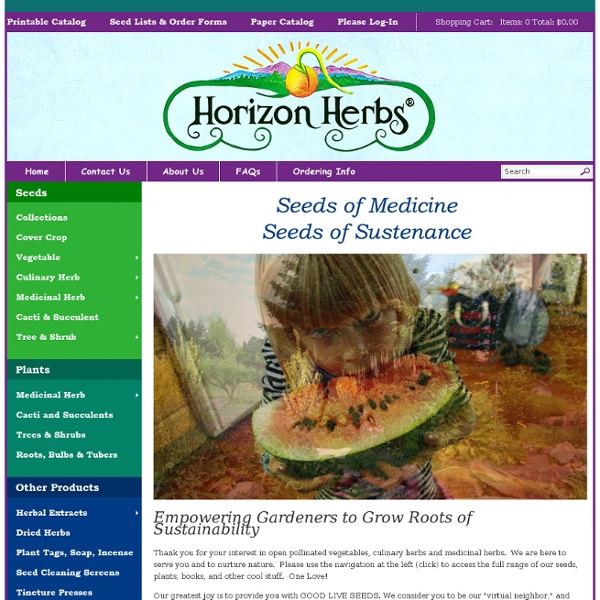Evergreen Seeds - Asian Vegetable Seeds
Your source for Wiccan, Pagan, Occult, Ritual and Spiritual supplies
Filaree Garlic Farm
Growing a Witch's Garden - Seeds from Alchemy Works
Growing a Witch's Garden Whether you are Wiccan or traditional, coven member or solitary, kitchen or hedge witch, a garden can be a powerful and vitalizing part of your magical practice. Growing herbs you will eventually make part of your spellwork allows you to build both a deep knowledge of and a relationship with those plants from the time they are embryos in the seed until they are mature and ready to harvest; this can add a great deal of power and focus to your work. Siting Your GardenWhen you are planning a witch's garden, ask the spirits of the place for help in siting it and keep in mind the interaction between human and non-human a garden entails. Garden InteractionA garden is a meeting place between human culture and plant culture. A Place to Sit and Ponder I'm not much on plastic, but I love those plastic Adirondack chairs for the garden. Magical Practice in Your Garden There are many ways to bring your magical practice into your garden. Start Small Know Your Limits Borders
Bountiful Gardens
Adaptive Seeds | Seed Embassador Project
Turtle Tree Seed
Cherry Gal - Heirloom Seeds
Home of CHERRYGAL HEIRLOOM SEEDS and offering gifts & decorations from these fine gourmet shops, artists, artisans and design houses: Andrea by Sadek, Art of the Garden, Barlean's Organic Oils, Bespoken Jewelry, Christian Ulbricht, Colonial Tin Works, Crosby & Taylor, Gaia Herbs, Glass Rocks, Health Basics, Indian Harvest Gourmet Grains, Jeff Price Art Glass, John & Kira's Chocolate, KRM Chocolates, Laura Ashley, Monkeez, Motherlove Herbal Company, Organic Homemade, Ragon House, Ramsay Crowe, Reutter Porcelain, Silvie Goldmark Designs, Stonewall Kitchen, Vagabond House, Victorian Trading Co., and much more! We offer health, beauty, nostalgia, product excellence and great service! For all items tagged "Ships Now" including seeds, we process same to next business day (M-F). For non-seed items that are not "ships now," please check additional info in the item listing.
Perennials, Wildflower Plants for Sale - Buy new exotic & nativel plants, Buy Hosta for sale
Tripple Brook Farm Plant Nursery
At Tripple Brook Farm we strive to make our gardens as productive, attractive, interesting, and low-maintenance as possible - and to supply plants to help you do the same with your garden. We offer a wide range of plants, most of which are cold hardy in southern New England. We also offer uniquely versatile and effective tree transplanting equipment, as well as striking botanical posters and note cards featuring original art work. We ship plants continuously from early spring to late fall to all portions of the continental US except for California, Oregon, Washington, Arizona, and Nevada. Tripple Brook Farm Tree Digging Equipment and most other non-plant items can be shipped world-wide. You may order on-line, or by phone at (413) 527-4626. We sincerely hope you will find that we offer plants which will fit into your landscaping plans, and we hope that you will enjoy the process of acquiring new plants and learning to use them in your landscape as much as we do.
Log House Plants



